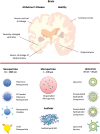Biomaterials for the Treatment of Alzheimer's Disease
- PMID: 27379232
- PMCID: PMC4909781
- DOI: 10.3389/fbioe.2016.00049
Biomaterials for the Treatment of Alzheimer's Disease
Abstract
Alzheimer's disease (AD) as a progressive and fatal neurodegenerative disease represents a huge unmet need for treatment. The low efficacy of current treatment methods is not only due to low drug potency but also due to the presence of various obstacles in the delivery routes. One of the main barriers is the blood-brain barrier. The increasing prevalence of AD and the low efficacy of current therapies have increased the amount of research on unraveling of disease pathways and development of treatment strategies. One of the interesting areas for the latter subject is biomaterials and their applications. This interest originates from the fact that biomaterials are very useful for the delivery of therapeutic agents, such as drugs, proteins, and/or cells, in order to treat diseases and regenerate tissues. Recently, manufacturing of nano-sized delivery systems has increased the efficacy and delivery potential of biomaterials. In this article, we review the latest developments with regard to the use of biomaterials for the treatment of AD, including nanoparticles and liposomes for delivery of therapeutic compounds and scaffolds for cell delivery strategies.
Keywords: Alzheimer’s disease; biomaterials; delivery systems; liposomes; nanoparticles; scaffolds.
Figures
References
Publication types
LinkOut - more resources
Full Text Sources
Other Literature Sources


